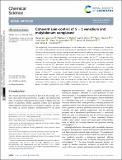Coherent spin-control of S = 1 vanadium and molybdenum complexes
Author(s)
Laorenza, Daniel W; Mullin, Kathleen R; Weiss, Leah R; Bayliss, Sam L; Deb, Pratiti; Awschalom, David D; Rondinelli, James M; Freedman, Danna E; ... Show more Show less
DownloadPublished version (1015.Kb)
Publisher with Creative Commons License
Publisher with Creative Commons License
Creative Commons Attribution
Terms of use
Metadata
Show full item recordAbstract
The burgeoning field of quantum sensing hinges on the creation and control of quantum bits. To date, the most well-studied quantum sensors are optically active, paramagnetic defects residing in crystalline hosts. We previously developed analogous optically addressable molecules featuring a ground-state spin-triplet centered on a Cr4+ ion with an optical-spin interface. In this work, we evaluate isovalent V3+ and Mo4+ congeners, which offer unique advantages, such as an intrinsic nuclear spin for V3+ or larger spin–orbit coupling for Mo4+, as optically addressable spin systems. We assess the ground-state spin structure and dynamics for each complex, illustrating that all of these spin-triplet species can be coherently controlled. However, unlike the Cr4+ derivatives, these pseudo-tetrahedral V3+ and Mo4+ complexes exhibit no measurable emission. Coupling absorption spectroscopy with computational predictions, we investigate why these complexes exhibit no detectable photoluminescence. These cumulative results suggest that design of future V3+ complexes should target pseudo-tetrahedral symmetries using bidentate or tridentate ligand scaffolds, ideally with deuterated or fluorinated ligand environments. We also suggest that spin-triplet Mo4+, and by extension W4+, complexes may not be suitable candidate optically addressable qubit systems due to their low energy spin-singlet states. By understanding the failures and successes of these systems, we outline additional design features for optically addressable V- or Mo-based molecules to expand the library of tailor-made quantum sensors.
Date issued
2024-08-05Department
Massachusetts Institute of Technology. Department of ChemistryJournal
Chemical Science
Publisher
Royal Society of Chemistry
Citation
Laorenza, Daniel W, Mullin, Kathleen R, Weiss, Leah R, Bayliss, Sam L, Deb, Pratiti et al. 2024. "Coherent spin-control of S = 1 vanadium and molybdenum complexes." Chemical Science, 15 (34).
Version: Final published version